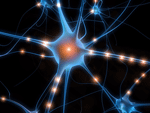Researchers at the University of North Florida and the Mayo Clinic in Jacksonville, Florida have shown how brain waves can be used to type alphanumeric characters on a computer screen. According to this story in the London Telegraph, "... patients could make letters appear on screen just by focusing on that letter when presented with a matrix of symbols."
Says this story appearing in the Science Daily, "By merely focusing on the "q" in a matrix of letters, for example, that "q" appears on the monitor."
The research was presented at the 2009 annual meeting of the American Epilepsy Society.
Mayo Clinic neurologist Jerry Shih, M.D, the Co-Principal Investigator, said that over 2 million people in the US alone suffering from neurological diseases or paralysis could benefit from assistive devices controlled such by a brain-computer interface.
The research effort receives National Science Foundation funding, and the explanation contained in the proposal sheds more light on the line of research being followed:
"A brain-computer interface (BCI) is a system that allows users, especially individuals with severe neuromuscular disorders, to communicate and control devices using their brain waves. ... Over the past two years, it has been demonstrated that a non-invasive, scalp-recorded electroencephalography (EEG) based BCI paradigm can be used by a disabled individual for long-term, reliable control of a personal computer. This BCI paradigm allows users to select from a set of symbols presented in a flashing visual matrix by classifying the resulting evoked brain responses. One of the goals of this project is to establish that the same BCI paradigm and techniques used for the aforementioned demonstration can be straightforwardly implemented to generate high-level commands for controlling a robotic manipulator in three dimensions according to user intent, and that such a BCI can provide superior dimensional control over alternative BCI techniques currently available, as well as a wider variety of practical functions for performing everyday tasks."
"Electrocorticography (ECoG), electrical activity recorded directly from the surface of the brain, has been demonstrated in recent preliminary work to be another potentially viable control for a BCI. ECoG has been shown to have superior signal-to-noise ratio, and spatial and spectral characteristics, compared to EEG. But the EEG signals used at present to operate BCIs have not been characterized in ECoG. The PI believes ECoG signals can be used to improve the speed and accuracy of BCI applications, including for example control of a robotic manipulator. Thus, additional goals of this project are to characterize evoked responses obtained from ECoG, to use them as control signals to operate a simulated robotic manipulator, and to assess the level of control (speed and accuracy) between the two recording modalities and compare the results to competitive BCI techniques."
The Telegraph story notes that, "Any future devices powered by brain waves would be likely to require surgery for them to be implanted in a patients skull and for the software to be calibrated for each individual."
It appears that it is still years away from being used practically, but it seems like a hopeful beginning.
Robert N. Charette is a Contributing Editor to IEEE Spectrum and an acknowledged international authority on information technology and systems risk management. A self-described “risk ecologist,” he is interested in the intersections of business, political, technological, and societal risks. Charette is an award-winning author of multiple books and numerous articles on the subjects of risk management, project and program management, innovation, and entrepreneurship. A Life Senior Member of the IEEE, Charette was a recipient of the IEEE Computer Society’s Golden Core Award in 2008.



